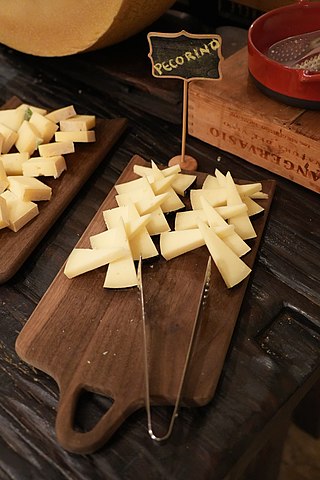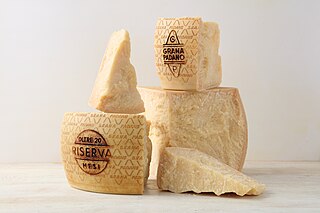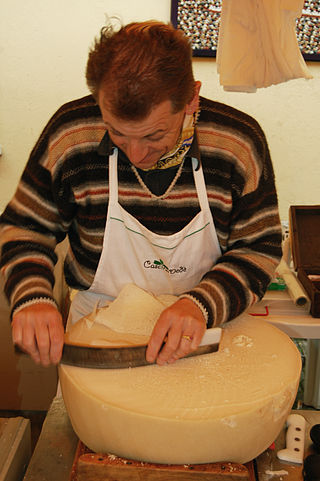
Pecorino romano is a hard, salty Italian cheese made with sheep's milk that is often used for grating over pasta or other dishes. The name pecorino simply means 'ovine' or 'of sheep' in Italian; the name of the cheese, although protected, is a description rather than a brand: [formaggio] pecorino romano simply means 'sheep's [cheese] of Rome'.

Pecorino is an Italian hard cheese produced from sheep's milk. The name pecorino derives from pecora, which means 'sheep' in Italian.

Parmesan is an Italian hard, granular cheese produced from cow's milk and aged at least 12 months or, outside the European Union, a locally produced imitation.

Asiago is a cow's milk cheese, first produced in Asiago in Italy, that can assume different textures according to its aging, from smooth for the fresh Asiago to a crumbly texture for the aged cheese. The aged cheese is often grated in salads, soups, pastas, and sauces while the fresh Asiago is sliced to prepare panini or sandwiches; it can also be melted on a variety of dishes and cantaloupe. It is classified as a Swiss-type or Alpine cheese.

Buffalo mozzarella is a mozzarella made from the milk of the Italian Mediterranean buffalo. It is a dairy product traditionally manufactured in Campania, especially in the provinces of Caserta and Salerno.

Fontina is a cow's milk cheese, first produced in Italy. Over time, production of Fontina has spread worldwide, including to the United States, Denmark, Sweden, Canada, France and Argentina.

Grana Padano is a cheese originating in the Po Valley, in northern Italy, similar to Parmesan. There are less strict regulations governing its production compared to Parmesan. This hard, crumbly-textured cheese is made with unpasteurized cows' milk that is semi-skimmed through a natural creaming process. To preserve the authenticity of the manufacturing processes and raw materials used to make this cheese, Grana Padano is registered as Geographical Indication in Italy since 1954 and as a European Union protected designation of origin (PDO) since 1996, and is protected in several other countries based on the Lisbon Agreement and bilateral agreements.

Balearic cuisine is a Mediterranean cuisine as cooked in the Balearic Islands, Spain. It can be regarded as part of a wider Catalan cuisine, since it shares many dishes and ingredients with Catalonia and the Valencian Community. Others view it as part of a more global Spanish cuisine. Traditional Balearic cuisine is rich in vegetables, cereal and legumes as well as being low in fats. A succinct selection of the primary dishes would be ensaimades, seafood and vegetable stews, sobrassada, coques, tombet, Maó cheese and wine.

Reggianito is an Argentine cheese that is a very hard, granular, cow's milk cheese. The cheese was developed by Italian immigrants to Argentina who wished to make a cheese reminiscent of their native Parmigiano Reggiano. The name—the Spanish diminutive of Reggiano—refers to the fact that the cheese is produced in small 6.8 kg (15 lb) wheels, rather than the huge Parmigiano-Reggiano drums.

Caprino is an Italian cheese traditionally made from whole or skimmed goat's milk. The name of the cheese derives from the Italian word for goat, capra. With modern methods of production, the cheese is made from cow's milk as well or a combination of both cow's and goat's milks. The two major styles of caprino are fresco ("fresh") and stagionato ("aged").

Granular cheese, also known as stirred curd cheese and hard cheese, is a type of cheese produced by repeatedly stirring and draining a mixture of curd and whey. It can refer to a wide variety of cheeses, including the grana cheeses such as Parmigiano-Reggiano (pictured) and various others.

There are many different types of cheese. Cheeses can be grouped or classified according to criteria such as length of fermentation, texture, methods of production, fat content, animal milk, and country or region of origin. The method most commonly and traditionally used is based on moisture content, which is then further narrowed down by fat content and curing or ripening methods. The criteria may either be used singly or in combination, with no single method being universally used.

The Abbey of Santa Maria di Rovegnano is a Cistercian monastic complex in the comune of Milan, Lombardy, northern Italy. The borgo that has developed round the abbey was once an independent commune called Chiaravalle Milanese, now included in Milan and referred to as the Chiaravalle district.

Pecorino toscano is a firm-textured ewe's milk cheese produced in Tuscany. Since 1996 it has enjoyed protected designation of origin (PDO) status.

Valtellina Casera is a cheese made from semi-skimmed cows' milk in the northern Italian province of Sondrio. Its origins date back to the sixteenth century and it is much used in the cuisine of the Valtellina: particularly in dishes based on buckwheat flour such as pizzoccheri and sciatt.

Swiss-type cheeses, also known as Alpine cheeses, are a group of hard or semi-hard cheeses with a distinct character, whose origins lie in the Alps of Europe, although they are now eaten and imitated in most cheesemaking parts of the world. Their distinct character arose from the requirements of cheese made in the summer on high Alpine grasslands, and then transported with the cows down to the valleys in the winter, in the historic culture of Alpine transhumance. Traditionally the cheeses were made in large rounds or "wheels" with a hard rind, and were robust enough for both keeping and transporting.

Silter is an Italian hard cheese made within the Lombardy region, around province of Brescia and surrounding areas, and traditionally produced with unpasteurised cows milk during summer months and September, is brined, and aged for a minimum of 6 months.
A Parmesan knife or grana knife is a knife with a drop-shaped blade and a round wooden handle used to break hard cheeses such as grana or Parmesan into shards. Bigger knives with a flat handle that can be hammered are used to cut open the cheese wheels, the crusts of which are rather hard.

Raspadüra is a way to serve grana cheese, presenting it as very thin sheets, scraped with a special knife from a wheel of Granone Lodigiano or from a "young" cheese of the grana family, that is aged from four to six months.

Argentine cheese is by far the most produced dairy product in the country, making Argentina the second largest cheese producer in Latin America and among the top 10 cheese-producing countries in the world. In addition, Argentina is the Latin American country that consumes the most cheese, with 12 kilos per capita per year. Production is mainly centered in the provinces of Córdoba, Santa Fe and Buenos Aires, in the Pampas region of the central and east-central parts of the country.


















